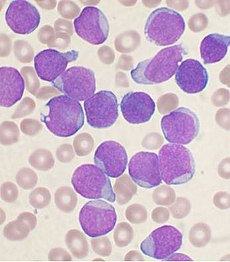 | |
| Wright Stained ALL Leukemia Cells in the Bone Marrow (1) |
In the original research paper (3), the research team found that there are two distinct cell types that are involved in the development and progression of cancer. These cell types include cells of origin of cancer (COC's) and cancer stem cells (CSC's). The COCs are cells that have already become cancerous or tumorous, whereas CSC are cells that are within a tumor, but still have a possibility of differentiating into other cell types. Referring back to the 1st week of class in which we were introduced to the terminology of cancer, Professor Islas had a good slide that summarized the type of cancer I am talking about here (see figure 1 below).
 |
| Figure 1 - Monoclonal tumors vs polyclonal tumors. Figure from
The Biology of Cancer (©
Garland Science 2007)
|
In addition to this basic concept, the researchers also found that the CSC can differentiate into either B-ALL (acute lymphoid leukemia) cancer cells or CML (chronic myeloid leukemia) cancer cells. The most interesting finding was that mechanism that determined how the CSCs became these different cell types. According to their research, if the CSCs were constantly signaled by IL-7 and BCR/ABLp185 (tyrosine kinase molecule), then the CSCs would differentiate into B-ALL, if the CSC's were signaled by STAT5 and BCR/ABLp210, then the CSC would differentiate into CML. As this research finding illustrates and as we discussed in class, tyrosine kinase molecules are an integral part in maintaining cell proliferative signaling and enabling the cancer to maintain itself.
This is an important piece of research that has been discovered in the last year or so because previously, oncologists and other researchers thought that cancer cells can arise only from pre-existing cells that have already differentiated and become mature. This research illustrates that even stem cells can become cancerous and isn't immune to the fundamental hallmarks of cancer.
As this research suggests, even though we are coming to terms with how differentiated, mature cancer cells work, this stumbling block represented by stem cell cancers makes treating cancer more difficult.
Questions
1. Since this research focused on stem cells, is it possible to sequence the genome of only stem cells and compare the gene expression of these cells and normal, differentiated, mature cells? If this can be done, then we can find out a pattern or group of genes that cause these stem cells to become cancerous and develop therapeutic targeted drugs that can eradicate this type of cancer.
What are your guy's thoughts?
